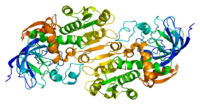
Photo from wikipedia
Nocardia cholesterolicum NRRL 5767 is well-known for its ability to convert oleic acid to 10-hydroxystearic acid (~88%, w/w) and 10-ketostearic acid (~11%, w/w). Conversion of oleic acid to 10-hydroxystearic acid… Click to show full abstract
Nocardia cholesterolicum NRRL 5767 is well-known for its ability to convert oleic acid to 10-hydroxystearic acid (~88%, w/w) and 10-ketostearic acid (~11%, w/w). Conversion of oleic acid to 10-hydroxystearic acid and then to 10-ketostearic acid has been proposed to be catalyzed by oleate hydratase and secondary alcohol dehydrogenase, respectively. Hydroxy fatty acids are value-added with many industrial applications. The objective of this study was to improve the Nocardia cholesterolicum NRRL5767 strain by CRISPR/Cas9 genome editing technology to knockout the secondary alcohol dehydrogenase gene, thus blocking the conversion of 10-hydroxystearic acid to 10-ketostearic acid. The improved strain would produce 10-hydroxystearic acid solely from oleic acid. Such improvement would enhance the production of 10-hydroxystearic acid by eliminating downstream separation of 10-hydroxystearic acid from 10-ketostearic acid. Here, we report: (1) Molecular cloning and characterization of two functional recombinant oleate hydratase isozymes and a functional recombinant secondary alcohol dehydrogenase from Nocardia cholesterolicum NRRL5767. Existence of two oleate hydratase isozymes may explain the high conversion yield of 10-hydroxystearic acid from oleic acid. (2) Construction of a CRISPR/Cas9/sgRNA chimeric plasmid that specifically targeted the secondary alcohol dehydrogenase gene by Golden Gate Assembly. (3) Transformation of the chimeric plasmid into Nocardia cholesterolicum NRRL 5767 by electroporation and screening of secondary alcohol dehydrogenase knockout mutants. Two mutants were validated by their lack of secondary alcohol dehydrogenase activity at the protein level and mutation at the targeted 5’ coding region and the 5’ upstream at the DNA level. The knockout mutants offer improvements by converting added oleic acid to solely 10-hydroxystearic acid, thus eliminating downstream separation of 10-hydroxystearic acid from 10-ketostearic acid. To the best of our knowledge, we report the first successful knockout of a target gene in the Nocardia species using CRISPR/Cas9/sgRNA-mediated genome editing technology.
Journal Title: PLoS ONE
Year Published: 2020
Link to full text (if available)
Share on Social Media: Sign Up to like & get
recommendations!